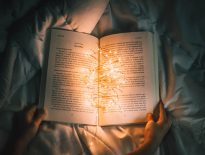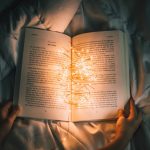Beginnings
On the internet, there are thousands of “formal definitions” of poetry begging to be read. That is not our concern. Our focus shall be on the meaning of poetry sifted from lived experiences.
To begin, you may consider these posers:
- Have you ever come across a cluster of words and expressions that hold several layers of meaning?
- Have you ever encountered an expression that has hints of regular rhythm and may strongly appeal to (any or all the) senses through the use of imagery?
While you may be mulling over these questions above, consider the opening soliloquy in the animated movie– Puss in Boots: The Last Wish (2022):
Star light, star bright
First star I see tonight.
I wish I may, I wish I might
Have this wish I wish tonight.
— The Last Wish.
Some Elemental Traits of Poetry
From the excerpt above, it is easy to understand that poetry is a genre of literature that is mostly written in “elevated” or condensed language. The poem above clearly differs from the usual everyday-normal expressions employed in regular conversations.
First, you’d notice the rhythm and cadence (or graceful flow of words). Secondly, you’d notice the imagery of “the Night” or better still, the picture of a starlit night. More importantly, you may have also noticed the packed and overflowing emotions of the speaker– something sort of deep wistfulness.
To consolidate further on the uniqueness of poetry as a figurative language, Parlin Pardede’s Introduction to poetry: Definition and types notes thus:
The elements of poetry are figures, and poetry itself is a language of figures, in which each component can potentially open toward new meanings, levels, dimensions, connections, or resonances. Poetry does this through its careful, intricate pattern of words. It offers language as highly organised as language can be.
Poetry is written in a well-patterned language. In essence, there is no wasted word. Each word spent, serves a superficial or underlying purpose (or in most times, both). No word is idle or accidental. Together these words give birth to meaningful and beautiful designs. A convergence of these words, is often referred to as “poetic line” since such lines will usually be marked by a high incidence of imagery, metaphor and the rich sounding of sounds. Drawing from the example of “the Last Wish”, each syllable, each word, and even the (line) breaks enhanced the musical quality and rhythmic flow/pattern of the poem.
Read – What Makes a Good Poem (Part 1) by Meckson Germanus Kaboga (Tanzania)
Of course there are many other traits that earmark poetry as being distinct from the other genres of literature. And while no trait is dispensable, there are traits whose presence in poems is oftentimes, non-negotiable. Cadence, Rhythm and Imagery are 3 of such elemental traits in poetry.
Rhythm: Consider verse 6 of Sir Walter Raleigh’s The Soul’s Errand:
Tell Zeal it wants devotion
Tell Love it is but lust;
Tell Time it is but motion;
Tell Flesh it is but dust;
And wish them not reply,
For thou must give the lie.
Borrowing the words of Jeffrey Wainwright, the rhythm created in each of the lines above is “a sound in the head, and in the ear…”. Notice the way Walter’s poem has manipulated time by the deployment of pace, length of syllable and emphasis–or beat which is very decisive. These qualities converge to constitute Cadence. Cadence is sourced from Latin and Italian words which mean “to fall”. Hence, cadence is created when particular sounds of words when being matched with another like sound, do make a concord or pleasing harmony of sound. It is in this respect that poetry is closest to music.
Essentially, sound techniques/devices rank high as one of the most important elements in poetry. In each of the lines of Sir Walter’s poem (cited above), there is a noticeable rise and fall in inflection. Line 2 is earmarked by alliteration: Love…lust. So is line 3 as well: Tell Time. There is also the effect of assonance, and the magic of the alternate end rhymes as well. To stress again on the point being made, sound devices are very important in the composition of poetic lines.
Imagery: Can you paint a picture with words? Can you use figurative language to evoke or inspire a sensory experience in your reader? If you (as a poet) can employ descriptive words so well, to a point that you can play to your reader’s senses, giving him/her sights and scenes, smells, sounds and feelings, then you are probably very good with employing “imagery”. Imagery is a magical poetic device. And it works by bringing to live, the work being consumed by the reader.
Very good poems live on in the mind of the reader; long after the poem has been read and perhaps forgotten. It is important that a poet should not focus only on the visual imagery. As noted earlier, imagery can be nasal, auditory, of touch and of taste. A mix of these will make for a rich image. For an example of the visual imagery, consider the underlined words in Sarah Russell’s If I Had Three Lives:
If I had three lives, I’d marry you in two.
The other? Perhaps that life over there
at Starbucks, sitting alone, writing—a memoir,
maybe a novel or this poem. No kids probably,
a small apartment with a view of the river,
and books—lots of books—and time to read.
The underlined words in the excerpt above exemplify the visual kind of imagery. Visual imagery describes what we can see. A memoir, a novel, an apartment by the river and lots of books, are things that can be seen. For an example of imagery based on taste, consider the underlined words culled from my poem, Lollipop’s Conversation with a Priest:
Lollipop:
Father,
I am shaman, much like you,
In the red light regions.
Men, Useless lot of them
are bland on my bewitching tongue
and I exhale them like smoke
incense offered to my unyielding heart.
You should have noticed that “bland” and “tongue” are words which are suggestive of the gustatory imagery.
Poetry: The Lived Experience
A poem is usually written to draw the reader into the poet’s world, possibly, to encounter the lived experience of the writer. Hence, poetry as a lived experience, entails allowing the reader to connect with a poem on a deeper, more personal level. Recall that the speaker in the “Last Wish” seems to yearn for something. There is a hint of wistfulness in his voice. To understand this analysis, it is worthwhile to give a succinct synopsis of the animated movie, “Puss in Boots: The Last Wish”.
Read – Structured Poetry: Villanelle by Chipo Chama (Zambia)
Puss (a cat), is well known for his adventurous nature. To the people of Del Mar, he is a hero. Because he is gifted with 9 lives, he adopts a carefree attitude in the face of danger, oftentimes “laughing in the face of death”. And so, he dies and dies, until he is down to his 9th life. The quest for the wishing star pits him to battle several times against “Death” who is so pissed off by Puss’ flippant, arrogant attitude in the face of mortal danger/death. Hence, “the Last Wish” (supposedly to be granted by the wishing star,) is a burden of regrets at living recklessly and hoping for 9 more shots at life. This is the poet’s lived experience.
In the hit TV show– House of the Dragon (Season 1, Episode) King Viserys speaks to his wife, Queen Aemma Arryn:
The dream,
It was clearer than a memory.
Our son was born,
Wearing Aegon’s iron crown.
I heard the sound
Of thundering hooves
Splintering shields
And ringing swords.
And I placed our son
Upon the iron throne
And the bells of the sept tolled
And all the dragons roared as one.
– The Dream that Never Was
In this scene, the queen, heavy with child, was in her bathtub, as she conversed with the king about their search for a male heir to the iron throne. King Viserys, being optimistic that she would bear a son, said the above words to her. In the poem, there is a lived experience of desperate want and of faith, and of hope in the seemingly endless search and “wait” for a male heir. Note again the underlined words which earmark various sound devices that enrich the flow and general outlook of the poem.
Bibliography/further readings
Internet sites:
- Universitas Kristen Indonesia, ‘Introduction to Poetry: Definitions and Types’ <https://parlindunganpardede.wordpress.com/2012/08/05/introduction-to-poetry-definitions-and-types/> (5/8/2012) last accessed 12 February 2023.
- Master Class, ‘Poetry 101: What Is Imagery? Learn About the 7 Types of Imagery in Poetry With Examples’ <https://www.masterclass.com/articles/poetry-101-what-is-imagery-learn-about-the-7-types-of-imagery-in-poetry-with-examples> ( 1/9/22) last accessed 12 February 2023.
- Chidiebere Udeokechukwu, ‘Lollipop’s Conversation With A Priest’ <https://www.ihraf.org/lollipops-conversation-with-a-priest> last accessed 12 February 2023.
- Sarah Russell, ‘If I had Three Lives’ < https://www.poetrynook.com/poem/member/if-i-had-three-lives > First published in Silver Birch Press, (Last accessed 12 February 2023).
Books:
- Parker EW (ed), A Pageant of Longer Poems ( Essex: Longman Group Ltd 1956).
- Jeffrey Wainwright, Poetry: The Basics ( New York: Routledge 2004)
Films/Shows
- Puss in Boots: The Last wish (2022, Animated movie)
- House of the Dragon, Season 1, episode 1
 Chidiebere Udeokechukwu is an Igbo Nigerian lawyer. He is a recipient of the 3rd prize for poetry in the 2022 CREATORS OF JUSTICE LITERARY AWARDS (IHRAF), was long-listed in the 2022 BRIEFLY WRITE POETRY PRIZE and has been long-listed in the 2023 WRITING UKRAINE PRIZE. He is a review writer for Writers Space Africa (WSA), and a poetry mentor for the WSA Academy. Chidiebere is also a poetry reader for Carve Magazine, a poetry editor for The Crusaders Magazine, and Flare Journal. His poems appear in Adanna, Irawo Poetry Anthology, Writers Space Africa Magazine, Small Leaf Press (Jaden) Magazine, PoeticAfrica, and Pride Magazine Nigeria.
Chidiebere Udeokechukwu is an Igbo Nigerian lawyer. He is a recipient of the 3rd prize for poetry in the 2022 CREATORS OF JUSTICE LITERARY AWARDS (IHRAF), was long-listed in the 2022 BRIEFLY WRITE POETRY PRIZE and has been long-listed in the 2023 WRITING UKRAINE PRIZE. He is a review writer for Writers Space Africa (WSA), and a poetry mentor for the WSA Academy. Chidiebere is also a poetry reader for Carve Magazine, a poetry editor for The Crusaders Magazine, and Flare Journal. His poems appear in Adanna, Irawo Poetry Anthology, Writers Space Africa Magazine, Small Leaf Press (Jaden) Magazine, PoeticAfrica, and Pride Magazine Nigeria.







